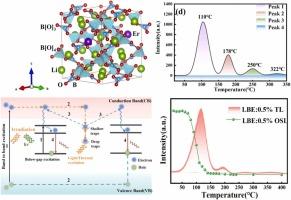稀土掺杂四硼酸锂用于光/热激发发光剂量测定
IF 6.3
2区 材料科学
Q2 CHEMISTRY, PHYSICAL
引用次数: 0
摘要
光激发发光(OSL)和热激发发光(TL)测试的辐射测量材料广泛应用于环境辐射监测、核医学和空间探索等领域。Li2B4O7 (LTB,四硼酸锂)具有与人体组织相似的等效原子序数,可以提高吸收剂量的准确性,扩大稀土元素调控的辐射剂量测定范围。采用水热法制备了不同Er离子掺杂的LTB陶瓷压块,并对其形貌特征、晶体结构和组成成分进行了系统表征。利用紫外-可见吸收光谱和光致发光光谱(PL)研究了不同掺杂水平下的特征发光光谱和浓度猝灭效应,并对元素氧化态、结合能和杂质诱导能级进行了分析。结果表明,LTBE: Er(0.5 mol.%)样品的发光强度最高。然而,随着掺杂浓度的降低,发光寿命从6.13 ms缩短至3.98 ms。为了评估OSL/TL的性能,研究了它们的重复性和再现性,并对发光曲线进行了精确的反褶积,从而通过动力学分析对活化能和频率因子等陷阱参数进行了严格的量化。揭示了随时间变化的发光衰减行为与陷阱分布之间的相关性,并阐明了相互竞争的电子重捕获过程和辐射诱导的缺陷构型如何共同控制光激发的电荷转移动力学。优化后的样品具有良好的OSL剂量响应特性,在0.05 ~ 250 Gy范围内呈良好的线性关系。稀土元素的精确掺杂为优化LTBE的OSL/TL性能提供了原子水平调制。本文章由计算机程序翻译,如有差异,请以英文原文为准。

Rare Earth Doped Lithium Tetraborate for Optically/Thermally Stimulated Luminescence Dosimetry
Radiometry materials tested from optically stimulated luminescence (OSL) and thermally stimulated luminescence (TL) are widely used in environmental radiation monitoring, nuclear medicine and space exploration. Li2B4O7 (LTB, Lithium tetraborate) with similar equivalent atomic number to that of human tissue, which can improve the absorbed dose accuracy and broaden the radiation dosimetry range with rare earth elements regulation. LTB ceramic compacts by different Er ions doping were prepared by the hydrothermal method, then their morphological features, crystal structures, and compositional components were systematically characterized. The characteristic luminescence spectra and concentration quenching effects at different doping levels were investigated using UV-vis absorption and photoluminescence (PL) spectroscopy, complemented by analysis of elemental oxidation states, binding energies, and impurity-induced energy levels. It was found that the LTBE: Er(0.5 mol.%) sample exhibited the highest luminescence intensity. However, as the doping concentration decreased, the luminescence lifetime shortened from 6.13 ms to 3.98 ms. For OSL/TL performance evaluation, their repeatability and reproducibility were investigated, and the precise deconvolution of the luminescence curves enables rigorous quantification of trap parameters with activation energy and frequency factor through kinetic analysis. The correlation between time-dependent luminescence decay behavior and trap distribution is revealed, and we elucidate how competing electron retrapping processes and radiation-induced defect configurations collectively govern the photo-stimulated charge transfer dynamics. The optimized sample demonstrated excellent OSL dose–response characteristics, showing good linearity over a range of 0.05–250 Gy. The precise doping of rare earth elements provides atomic-level modulation for optimizing the OSL/TL performance of LTBE as radiation dosimetry.
求助全文
通过发布文献求助,成功后即可免费获取论文全文。
去求助
来源期刊

Journal of Alloys and Compounds
工程技术-材料科学:综合
CiteScore
11.10
自引率
14.50%
发文量
5146
审稿时长
67 days
期刊介绍:
The Journal of Alloys and Compounds is intended to serve as an international medium for the publication of work on solid materials comprising compounds as well as alloys. Its great strength lies in the diversity of discipline which it encompasses, drawing together results from materials science, solid-state chemistry and physics.
 求助内容:
求助内容: 应助结果提醒方式:
应助结果提醒方式:


